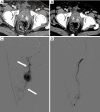Bleeding after prostatectomy: endovascular management
- PMID: 31183320
- PMCID: PMC6534764
- DOI: 10.21037/gs.2019.02.03
Bleeding after prostatectomy: endovascular management
Abstract
Background: To evaluate role of interventional radiology (IR) in post-surgical haemorrhagic complications of prostatectomy.
Methods: A retrospective study was performed. From April 2015 to January 2018, 10 patients referred to IR Department for haemorrhagic complications post radical prostatectomy (RP). All patients (mean age: 68.5 years; range, 58-85 years) were successfully treated with superselective trans-arterial embolization. We evaluated technical and clinical success and post procedural complications.
Results: Technical and clinical success was 100% (10/10) and no major complications were identified. No complications related to the endovascular procedures occurred. No recurrences during follow-up (8-20 months) were observed. Among minor complications, only 20% (2/10) developed mild post embolization syndrome.
Conclusions: The endovascular management of significant haemorrhage after prostatectomy is safe and long-term effective, with no major ischaemic events associated to embolization.
Keywords: Transarterial embolization; angiography; interventional radiology (IR); prostate bleeding; surgical complications.
Conflict of interest statement
Conflicts of Interest: The authors have no conflicts of interest to declare.
Figures



References
LinkOut - more resources
Full Text Sources
Miscellaneous
